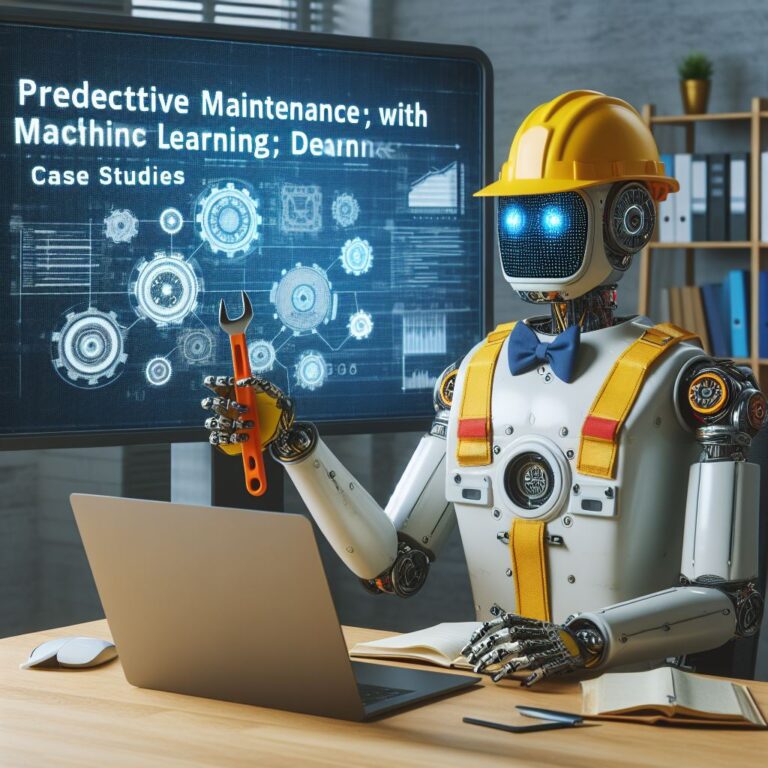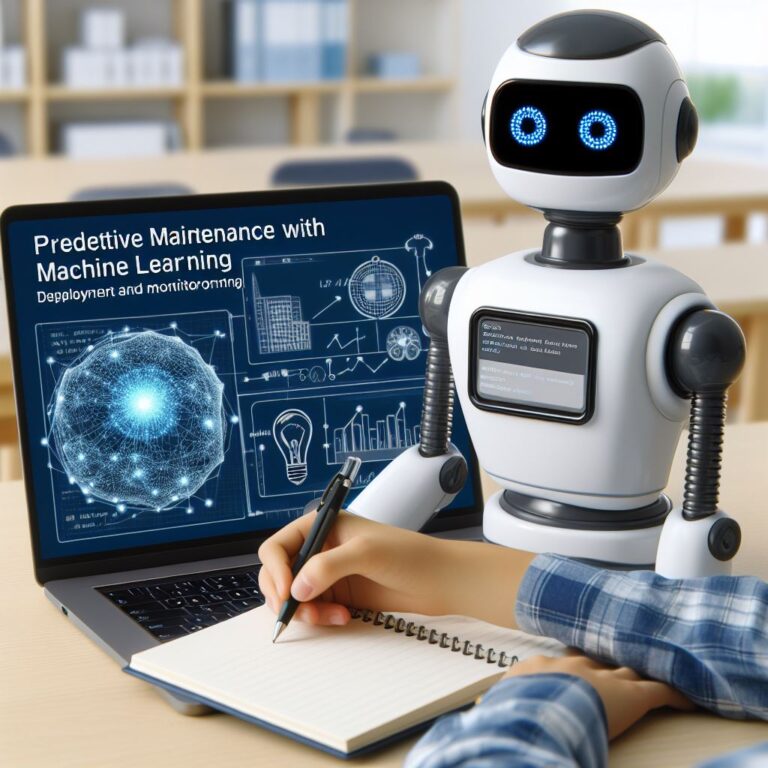1. What is Predictive Maintenance?
Predictive maintenance is a proactive approach to maintaining equipment and systems that aims to prevent failures and optimize performance. Predictive maintenance uses data from sensors, historical records, and external sources to monitor the condition and behavior of assets and predict when they need maintenance or repair. Predictive maintenance can help you reduce downtime, improve efficiency, save costs, and enhance safety.
But how can you predict when an asset will fail or need maintenance? This is where machine learning comes in. Machine learning is a branch of artificial intelligence that enables computers to learn from data and make predictions. Machine learning can help you analyze complex and large-scale data, identify patterns and anomalies, and generate accurate and reliable forecasts.
In this blog, you will learn how machine learning can enable predictive maintenance and what are the steps and challenges involved in implementing it. You will also see some examples and applications of predictive maintenance with machine learning in different industries. By the end of this blog, you will have a better understanding of what predictive maintenance is and how machine learning can help you achieve it.
2. Why is Predictive Maintenance Important?
Predictive maintenance is important because it can help you achieve several benefits for your business and operations. Some of the main benefits are:
- Reduced downtime: By predicting when an asset will fail or need maintenance, you can avoid unexpected breakdowns and interruptions that can affect your productivity and revenue. You can also plan your maintenance activities in advance and optimize your resources and schedules.
- Improved efficiency: By maintaining your assets in optimal condition, you can improve their performance and output. You can also reduce energy consumption and waste, and increase the lifespan of your assets.
- Saved costs: By preventing failures and reducing downtime, you can save on repair and replacement costs. You can also optimize your maintenance costs by avoiding unnecessary or excessive maintenance activities.
- Enhanced safety: By detecting and preventing potential failures, you can reduce the risk of accidents and injuries that can harm your workers and customers. You can also comply with safety and quality standards and regulations.
These benefits can give you a competitive edge and increase your customer satisfaction and loyalty. But how can you achieve these benefits with machine learning? In the next section, you will learn how machine learning enables predictive maintenance and what are the steps and challenges involved in implementing it.
3. How Machine Learning Enables Predictive Maintenance
Machine learning enables predictive maintenance by providing you with the tools and techniques to analyze your data and generate predictions. Machine learning can help you with the following tasks:
- Data collection and processing: Machine learning can help you collect and process data from various sources, such as sensors, logs, databases, and external sources. You can use machine learning to clean, transform, and integrate your data, and prepare it for further analysis.
- Feature engineering and selection: Machine learning can help you extract and select the most relevant and informative features from your data. Features are the attributes or variables that describe your data and can be used to make predictions. You can use machine learning to create new features, reduce the dimensionality of your data, and select the best features for your predictive model.
- Model building and evaluation: Machine learning can help you build and evaluate your predictive model. A predictive model is a mathematical function that maps your features to your target variable, which is the outcome you want to predict. You can use machine learning to choose the best algorithm, train your model, test your model, and measure its performance.
- Model deployment and monitoring: Machine learning can help you deploy and monitor your predictive model. You can use machine learning to integrate your model with your existing systems, automate your maintenance decisions, and update your model with new data and feedback.
These are the main steps involved in implementing predictive maintenance with machine learning. However, each step comes with its own challenges and opportunities, which we will discuss in the next section.
3.1. Data Collection and Processing
The first step in implementing predictive maintenance with machine learning is to collect and process your data. Data is the foundation of any machine learning project, and the quality and quantity of your data will determine the success of your predictive model. Therefore, you need to ensure that your data is relevant, reliable, and representative of your problem domain.
There are various sources of data that you can use for predictive maintenance, such as:
- Sensors: Sensors are devices that measure physical properties, such as temperature, pressure, vibration, sound, etc. Sensors can provide real-time and continuous data on the condition and performance of your assets.
- Logs: Logs are records of events or activities, such as maintenance history, failure reports, error messages, etc. Logs can provide historical and contextual data on the events and actions that affect your assets.
- Databases: Databases are collections of structured or unstructured data, such as asset specifications, operational parameters, environmental factors, etc. Databases can provide additional and complementary data on the characteristics and factors that influence your assets.
- External sources: External sources are data from outside your organization, such as weather data, market data, customer feedback, etc. External sources can provide useful and relevant data on the external conditions and trends that impact your assets.
Once you have collected your data from various sources, you need to process it to make it suitable for machine learning. Data processing involves several steps, such as:
- Data cleaning: Data cleaning is the process of removing or correcting any errors, inconsistencies, outliers, or missing values in your data. Data cleaning can improve the accuracy and reliability of your data.
- Data transformation: Data transformation is the process of changing the format, structure, or scale of your data. Data transformation can make your data more compatible and consistent with your machine learning algorithm.
- Data integration: Data integration is the process of combining data from different sources into a single dataset. Data integration can enrich and enhance your data by providing more information and diversity.
Data collection and processing is a crucial and challenging step in predictive maintenance with machine learning. You need to ensure that your data is sufficient, relevant, and reliable to build a robust and effective predictive model. In the next section, you will learn how to extract and select the most informative features from your data.
3.2. Feature Engineering and Selection
The second step in implementing predictive maintenance with machine learning is to extract and select the most informative features from your data. Features are the attributes or variables that describe your data and can be used to make predictions. Feature engineering and selection are important because they can improve the performance and interpretability of your predictive model.
Feature engineering is the process of creating new features from your existing data. You can use various techniques to engineer new features, such as:
- Aggregation: Aggregation is the process of combining multiple values into a single value, such as the mean, median, sum, count, etc. Aggregation can help you reduce the noise and variability in your data and capture the overall trend or pattern.
- Transformation: Transformation is the process of changing the representation or scale of your data, such as the logarithm, square root, power, etc. Transformation can help you normalize your data and make it more suitable for your machine learning algorithm.
- Encoding: Encoding is the process of converting categorical or textual data into numerical data, such as one-hot encoding, label encoding, hashing, etc. Encoding can help you represent your data in a format that your machine learning algorithm can understand and process.
- Generation: Generation is the process of creating new features from existing features, such as the difference, ratio, product, etc. Generation can help you create more informative and relevant features that capture the relationship or interaction between your existing features.
Feature selection is the process of choosing the best features from your existing or engineered features. You can use various criteria to select the best features, such as:
- Relevance: Relevance is the degree to which a feature is related to your target variable. You can use correlation, mutual information, or other measures to assess the relevance of a feature. You want to select the features that have high relevance to your target variable.
- Redundancy: Redundancy is the degree to which a feature is related to other features. You can use correlation, variance inflation factor, or other measures to assess the redundancy of a feature. You want to avoid the features that have high redundancy with other features.
- Importance: Importance is the degree to which a feature contributes to the performance of your predictive model. You can use feature importance scores, permutation tests, or other methods to assess the importance of a feature. You want to select the features that have high importance to your predictive model.
Feature engineering and selection are challenging and iterative steps in predictive maintenance with machine learning. You need to experiment with different techniques and criteria to find the optimal set of features for your predictive model. In the next section, you will learn how to build and evaluate your predictive model.
3.3. Model Building and Evaluation
The third step in implementing predictive maintenance with machine learning is to build and evaluate your predictive model. A predictive model is a mathematical function that maps your features to your target variable, which is the outcome you want to predict. For example, you may want to predict the remaining useful life of an asset, the probability of failure of an asset, or the optimal maintenance schedule for an asset.
There are various types of machine learning algorithms that you can use to build your predictive model, such as:
- Regression: Regression is a type of machine learning algorithm that predicts a continuous numerical value, such as the remaining useful life of an asset. Regression algorithms include linear regression, polynomial regression, decision tree regression, etc.
- Classification: Classification is a type of machine learning algorithm that predicts a discrete categorical value, such as the failure or non-failure of an asset. Classification algorithms include logistic regression, k-nearest neighbors, support vector machines, etc.
- Clustering: Clustering is a type of machine learning algorithm that groups similar data points together, such as the different types of failure modes of an asset. Clustering algorithms include k-means, hierarchical clustering, density-based clustering, etc.
- Time series: Time series is a type of machine learning algorithm that analyzes data that is ordered in time, such as the sensor readings of an asset over time. Time series algorithms include autoregressive models, moving average models, exponential smoothing models, etc.
- Deep learning: Deep learning is a type of machine learning algorithm that uses multiple layers of artificial neural networks to learn complex patterns and relationships from data, such as the images or sounds of an asset. Deep learning algorithms include convolutional neural networks, recurrent neural networks, long short-term memory networks, etc.
Once you have chosen the best algorithm for your problem, you need to train your model using your data. Training your model involves finding the optimal parameters that minimize the error between your predictions and the actual outcomes. You can use various methods to train your model, such as gradient descent, stochastic gradient descent, batch gradient descent, etc.
After you have trained your model, you need to evaluate your model using your data. Evaluating your model involves measuring how well your model performs on new and unseen data. You can use various metrics to evaluate your model, such as:
- Accuracy: Accuracy is the proportion of correct predictions over the total number of predictions. Accuracy can be used to evaluate classification models.
- Precision: Precision is the proportion of correct positive predictions over the total number of positive predictions. Precision can be used to evaluate classification models.
- Recall: Recall is the proportion of correct positive predictions over the total number of actual positive outcomes. Recall can be used to evaluate classification models.
- F1-score: F1-score is the harmonic mean of precision and recall. F1-score can be used to evaluate classification models.
- Mean squared error: Mean squared error is the average of the squared differences between the predictions and the actual outcomes. Mean squared error can be used to evaluate regression models.
- Root mean squared error: Root mean squared error is the square root of the mean squared error. Root mean squared error can be used to evaluate regression models.
- R-squared: R-squared is the proportion of the variance in the actual outcomes that is explained by the model. R-squared can be used to evaluate regression models.
Model building and evaluation are iterative and experimental steps in predictive maintenance with machine learning. You need to try different algorithms, parameters, and metrics to find the best model for your problem. In the next section, you will learn how to deploy and monitor your predictive model.
3.4. Model Deployment and Monitoring
The fourth and final step in implementing predictive maintenance with machine learning is to deploy and monitor your predictive model. Deploying your model means integrating it with your existing systems and processes, such as your asset management system, your maintenance scheduling system, your alert system, etc. Monitoring your model means tracking its performance and behavior over time, such as its accuracy, reliability, stability, etc.
Deploying and monitoring your model are important because they can help you realize the benefits and value of your predictive model. Deploying your model can help you automate your maintenance decisions and actions, such as when to perform maintenance, what type of maintenance to perform, how to allocate your resources and budget, etc. Monitoring your model can help you evaluate your model’s effectiveness and efficiency, such as how well it predicts the outcomes, how much it saves you in costs and time, how much it improves your safety and quality, etc.
There are various tools and techniques that you can use to deploy and monitor your model, such as:
- Application programming interfaces (APIs): APIs are interfaces that allow your model to communicate and interact with other systems and applications. APIs can help you integrate your model with your existing systems and processes, and expose your model’s functionality and predictions to other users and stakeholders.
- Dashboard and visualization tools: Dashboard and visualization tools are tools that allow you to display and analyze your model’s performance and behavior. Dashboard and visualization tools can help you monitor your model’s metrics and indicators, such as accuracy, error, bias, variance, etc. They can also help you visualize your model’s predictions and outcomes, such as the remaining useful life, the failure probability, the maintenance schedule, etc.
- Feedback and update mechanisms: Feedback and update mechanisms are mechanisms that allow you to collect and incorporate new data and feedback into your model. Feedback and update mechanisms can help you improve your model’s performance and behavior, by adjusting your model’s parameters, adding new features, or retraining your model with new data.
Deploying and monitoring your model are challenging and continuous steps in predictive maintenance with machine learning. You need to ensure that your model is integrated and aligned with your business and operational goals and objectives, and that your model is updated and maintained with the latest data and feedback. In the next section, you will learn about the challenges and opportunities of predictive maintenance with machine learning.
4. Challenges and Opportunities of Predictive Maintenance with Machine Learning
Predictive maintenance with machine learning is a promising and powerful approach to optimize your maintenance activities and achieve your business and operational goals. However, it is not without its challenges and opportunities. In this section, you will learn about some of the main challenges and opportunities of predictive maintenance with machine learning, and how you can overcome or leverage them.
Some of the main challenges of predictive maintenance with machine learning are:
- Data quality and availability: Data is the key ingredient of any machine learning project, and predictive maintenance is no exception. However, data quality and availability can be a major challenge for predictive maintenance, as you may face issues such as missing data, noisy data, inconsistent data, insufficient data, etc. These issues can affect the accuracy and reliability of your predictive model, and limit its applicability and scalability. To overcome this challenge, you need to ensure that your data is collected and processed properly, and that you have enough data to represent your problem domain and capture the variability and complexity of your assets.
- Model complexity and interpretability: Model complexity and interpretability are two conflicting aspects of any machine learning project, and predictive maintenance is no exception. On one hand, you want your model to be complex enough to capture the nonlinear and dynamic relationships and patterns in your data, and to provide accurate and robust predictions. On the other hand, you want your model to be interpretable enough to explain the logic and reasoning behind its predictions, and to provide actionable and meaningful insights. To balance this trade-off, you need to choose the appropriate machine learning algorithm, parameter, and metric for your problem, and to use techniques such as feature importance, partial dependence plots, or explainable AI to enhance your model’s interpretability.
- Model validation and verification: Model validation and verification are two essential steps of any machine learning project, and predictive maintenance is no exception. Model validation is the process of evaluating how well your model performs on new and unseen data, and model verification is the process of ensuring that your model meets the specifications and requirements of your problem. However, model validation and verification can be challenging for predictive maintenance, as you may face issues such as data scarcity, data imbalance, data drift, etc. These issues can affect the generalization and robustness of your model, and lead to overfitting or underfitting. To address this challenge, you need to use techniques such as cross-validation, bootstrapping, or synthetic data generation to validate and verify your model.
Some of the main opportunities of predictive maintenance with machine learning are:
- Data analytics and visualization: Data analytics and visualization are two powerful tools that can help you gain insights and value from your data, and predictive maintenance is no exception. Data analytics and visualization can help you explore and understand your data, identify patterns and anomalies, discover relationships and correlations, and communicate and present your findings. Data analytics and visualization can also help you monitor and evaluate your model’s performance and behavior, and provide feedback and recommendations for improvement. To take advantage of this opportunity, you need to use tools and techniques such as dashboard, charts, graphs, maps, etc. to analyze and visualize your data and model.
- Model optimization and improvement: Model optimization and improvement are two continuous processes that can help you enhance your model’s performance and behavior, and predictive maintenance is no exception. Model optimization and improvement can help you fine-tune your model’s parameters, add new features, or retrain your model with new data and feedback. Model optimization and improvement can also help you adapt your model to changing conditions and requirements, and to incorporate new knowledge and information. To seize this opportunity, you need to use methods and mechanisms such as grid search, feature engineering, or feedback and update mechanisms to optimize and improve your model.
- Model integration and automation: Model integration and automation are two ultimate goals that can help you realize the benefits and value of your model, and predictive maintenance is no exception. Model integration and automation can help you integrate your model with your existing systems and processes, and automate your maintenance decisions and actions. Model integration and automation can also help you scale up your model to handle more assets and scenarios, and to provide more services and solutions. To achieve this opportunity, you need to use tools and techniques such as APIs, cloud computing, or edge computing to integrate and automate your model.
Predictive maintenance with machine learning is a challenging and rewarding approach that can help you optimize your maintenance activities and achieve your business and operational goals. By understanding and addressing the challenges, and by exploring and exploiting the opportunities, you can make the most of predictive maintenance with machine learning. In the next and final section, you will learn about the conclusion and future directions of predictive maintenance with machine learning.
5. Conclusion and Future Directions
In this blog, you have learned what predictive maintenance is and how machine learning can help you achieve it. You have also learned about the steps and challenges involved in implementing predictive maintenance with machine learning, and the benefits and opportunities that it can offer. Predictive maintenance with machine learning is a promising and powerful approach that can help you optimize your maintenance activities and achieve your business and operational goals.
However, predictive maintenance with machine learning is not a one-size-fits-all solution, and it requires careful planning and execution. You need to consider your problem domain, your data availability and quality, your model complexity and interpretability, your model validation and verification, your model deployment and monitoring, and your model optimization and improvement. You also need to choose the appropriate tools and techniques for each step, and to balance the trade-offs and constraints that may arise.
Predictive maintenance with machine learning is also a dynamic and evolving field, and it offers many possibilities and directions for future research and development. Some of the possible future directions are:
- Multi-modal and multi-source data analysis: Multi-modal and multi-source data analysis is the process of analyzing data from different modalities and sources, such as images, sounds, texts, etc. Multi-modal and multi-source data analysis can help you enrich and enhance your data and features, and provide more comprehensive and holistic insights and predictions.
- Transfer learning and domain adaptation: Transfer learning and domain adaptation are the processes of applying the knowledge and skills learned from one domain or task to another domain or task, such as from one asset type to another asset type. Transfer learning and domain adaptation can help you leverage the existing data and models, and reduce the data and computational requirements for your problem.
- Reinforcement learning and active learning: Reinforcement learning and active learning are the processes of learning from the feedback and interaction with the environment or the user, such as from the rewards or the queries. Reinforcement learning and active learning can help you improve your model’s performance and behavior, and adapt your model to changing conditions and requirements.
Predictive maintenance with machine learning is a challenging and rewarding approach that can help you optimize your maintenance activities and achieve your business and operational goals. By understanding and addressing the challenges, and by exploring and exploiting the opportunities, you can make the most of predictive maintenance with machine learning. We hope that this blog has given you a useful introduction and overview of predictive maintenance with machine learning, and that you will find it helpful for your own projects and applications.



